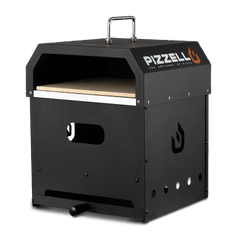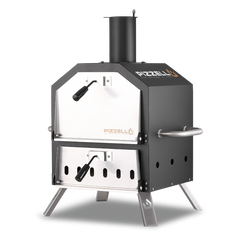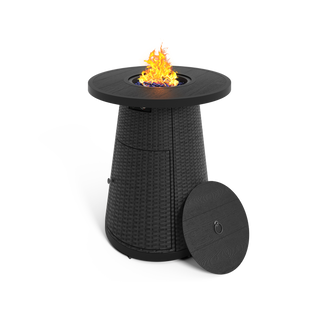Authentic Tips to Make Perfect Neapolitan Pizza Dough

Introduction
Neapolitan pizza dough is synonymous with simplicity and tradition, setting itself apart with its texture and taste from the myriad of pizza varieties available. The dough is the foundation of an authentic Neapolitan pizza, known for its crispy yet chewy crust, achieved through its unique ingredients and preparation techniques.
What Is Neapolitan Pizza Dough?
Neapolitan pizza dough is distinguished by its minimalistic approach, using only a few high-quality ingredients. The result is a dough that produces a pizza with a distinctive texture and flavor.
Key Characteristics of Authentic Neapolitan Pizza Dough
Authentic Neapolitan pizza dough can be distinguished by several defining characteristics:
- Flour: Typically made with Type 00 flour, finely ground and high in protein, contributing to the crust's texture.
- Hydration: A high hydration level, around 55% to 62%, is crucial for a light, airy crust.
- Yeast: A minimal amount of yeast is used, with a slow fermentation process over several hours to develop flavor.
- Salt: Enhances flavor, regulates yeast activity, and strengthens the gluten network.
- Kneading: The dough is delicately kneaded to avoid overworking the gluten, resulting in a tender bite.
- Proofing: Dough balls are left to proof at room temperature, allowing flavors and texture to develop.
- No Sugar or Oil: Genuine Neapolitan pizza dough does not contain sugar or oil, distinguishing its purity and taste.
Difference Between Neapolitan and Other Pizza Doughs
Neapolitan pizza dough prioritizes simplicity, high hydration, long fermentation, and an extremely fast bake to create a soft, chewy, lightly charred crust. Here are the key differences between Neapolitan pizza dough and other popular pizza dough styles:
Ingredients
Neapolitan pizza dough uses a very simple recipe with only four ingredients:
- Tipo 00 flour (finely milled Italian flour with 10-12% protein content)
- Water
- Salt
- Yeast (fresh yeast is traditional, but active dry yeast can also be used)
In contrast, other pizza dough styles, like New York and American, often include additional ingredients such as sugar and/or oil in the dough to help with browning and texture, higher protein flour like bread flour, and additional flavorings in the sauce like garlic, oregano, and red pepper flakes.
Hydration and Texture
Neapolitan pizza dough is very soft and elastic with hydration around 60-65%. This allows it to be stretched thinly by hand into a base with a thick, airy crust (cornicione) around the edges.
New York and other American pizza doughs have lower hydration around 60% and use higher protein flour, resulting in a sturdier dough that can be stretched more thinly and support more toppings. The crust is thin and crisp rather than soft and chewy.
Fermentation
Neapolitan dough undergoes a long, slow fermentation at room temperature for 16-24 hours to develop flavor and texture. Individual dough balls then proof for a few hours before baking.
New York dough is often cold-fermented for 1-3 days to fit a longer baking time. Other doughs, like deep-dish, are made fresh and proofed for just a few hours before baking.
Baking
Neapolitan pizza bakes at extremely high heat (800-900°F) for just 60-90 seconds, traditionally in a wood-fired oven. This creates a soft, moist center and charred, puffy crust.
New York and American pizzas bake at lower temperatures (500-600°F) for longer (8-15 mins) to uniformly crisp the sturdier dough. Deep-dish and pan pizzas bake at high heat in an oiled pan to fry the thick crust.
Ingredients Essential for Neapolitan Pizza Dough

Crafting the perfect Neapolitan pizza dough hinges upon selecting quality ingredients and understanding their unique contributions to texture, taste, and the fermentation process.
Choosing the Right Flour for Neapolitan Pizza
Here are the key factors to consider when choosing flour for making authentic Neapolitan pizza dough:
- Flour Type: The gold standard is Italian "Tipo 00" flour, which is finely milled and helps achieve the signature soft, elastic, and easily stretched dough.
- Protein Content: Look for Tipo 00 flour with 11-13% protein content. Lower protein helps achieve a soft, tender, and chewy crust.
- Gluten Development: The soft wheat in 00 flour has a weaker gluten structure, resulting in a softer, more elastic dough.
- Water Absorption: 00 flour absorbs less water, so dough recipes may need to be adjusted. Dough made with 00 flour will be stickier and wetter.
- Baking Results: Using 00 flour helps achieve a soft and tender inside with a thin crisp exterior and charred leopard spots on the crust from high-heat baking.
Using Fresh Yeast vs Dry Yeast
Fresh yeast is often preferred for Neapolitan pizza dough due to its reliability in the fermentation process. However, dry yeast is a convenient substitute that comes in two forms: active dry yeast and instant yeast. Active dry yeast requires rehydration, while instant yeast can be mixed directly with the flour.
The Role of Water and Salt in Dough Making
Water activates the yeast and binds with flour to form gluten, which is critical for the dough's structure. The temperature of the water should be carefully managed. Salt, specifically sea salt or kosher salt, is essential not only for flavor but also for strengthening gluten structure and controlling yeast activity.
How to Make Neapolitan Pizza Dough at Home?

Crafting Neapolitan pizza dough at home involves a series of meticulous steps to ensure a balance between texture and flavor.
Steps in Making the Dough
To begin making Neapolitan pizza dough, you will need the following basic ingredients:
- Flour (preferably '00' pizza flour for authenticity)
- Warm water
- Salt
- Yeast (active dry or instant)
Method
- Measure Ingredients: Start by measuring the flour, water, salt, and yeast precisely.
- Dissolve Yeast: Dissolve the yeast in warm water to activate it, which is essential for the dough to rise.
- Combine Ingredients: Mix the flour and salt together before slowly incorporating the yeast-water mixture.
- Initial Mix: Combine these ingredients until a rough dough begins to form.
Kneading the Dough: Essential Techniques

Proper kneading develops the gluten in the dough, which gives Neapolitan pizza its unique texture.
Hand Kneading
Press the dough with the heel of your hand, fold it over, and rotate it. Repeat this action for about 10-15 minutes.
Use of a Stand Mixer
If using a stand mixer, knead the dough with a dough hook attachment on a low to medium speed until the dough is smooth and elastic.
Dough Consistency
The dough should be tacky to the touch but not overly sticky. It must form a smooth ball that springs back when poked.
Let the Dough Sit: Fermentation Process
Fermentation is key to the flavor and structure of Neapolitan pizza dough.
First Rise
After kneading, shape the dough into a ball and place it in a lightly oiled bowl. Cover it with a damp cloth or plastic wrap and let it rise in a warm place until it doubles in size, which can take 1 to 2 hours.
Divide and Ball
Once risen, divide the dough into smaller portions and shape into balls.
Second Rise
These dough balls are left to ferment for an extended period, typically overnight in the refrigerator. This slow fermentation contributes to the development of flavor and the perfect crust texture.
Bring to Room Temperature
Before stretching, let the dough balls rest at room temperature for at least 1 hour to ensure optimal elasticity.
How to Achieve the Perfect Neapolitan Pizza Crust?

Achieving the perfect Neapolitan pizza crust requires mastery over dough stretching, proper use of baking tools such as a pizza stone or peel, and precise baking techniques.
Stretching the Dough Properly
Start with well-fermented Neapolitan pizza dough that's easy to stretch to avoid tearing. Gently form the cornicione—the edges of the pizza—while pushing the air towards it. A stand mixer can be used for the initial kneading, but the final stretch should be done by hand to achieve the authentic thin center and puffy edges.
Using a Pizza Stone or Pizza Peel
Preheat the stone in the oven to replicate the high-temperature surface of a traditional pizza oven. The high conductivity of a pizza stone or steel gives the crust its crisp exterior. A pizza peel allows for the smooth transfer of your pizza to and from the oven without deforming the crust. A light dusting of flour on the peel prevents sticking.
Baking Tips for Pizza Oven and Regular Oven
Neapolitan pizza thrives in high temperatures, usually above 800°F (425°C), which traditional pizza ovens can reach. For those using a regular oven, achieve a similar effect by setting it to the highest temperature and using a pizza stone to store and transfer heat. Pizzas should be baked rapidly to prevent drying out the dough. If aiming for an authentic experience, investing in a specialized pizza oven can offer the necessary performance. Consistency in baking times and temperatures is key to a perfect Neapolitan crust.
Common Mistakes to Avoid When Making Neapolitan Pizza Dough
Over-Kneading or Under-Kneading the Dough
Kneading develops the gluten in your dough, which is vital for the right texture. Over-kneading can lead to a tough and chewy crust, while under-kneading results in a dough lacking strength. Aim for a dough that is smooth, elastic, and just passes the windowpane test.
Improper Fermentation Times
The fermentation process is crucial for flavor and rise. Ensure to use fresh yeast and follow a typical Neapolitan dough timeline:
- Mix dough and bulk ferment at room temperature for 2 hours
- Divide into individual balls and cold ferment for 24-72 hours
- Proof at room temperature for 2-3 hours before stretching and baking
Incorrect Dough Stretching Techniques
Properly shape your Neapolitan pizza dough by hand, preserving its airy structure. Always start from the center and work your way outwards, leaving a thicker edge for the crust. This method ensures a thin, even base with a puffy rim, ready to be topped with your favorite ingredients.













 Aluminum Dining Table
Aluminum Dining Table
 WPC Dining Table
WPC Dining Table
 HDPE Dining Table
HDPE Dining Table
 Cart
Cart
 Gas Burner
Gas Burner
 Hat
Hat
 Apron
Apron
 Swivel Rocker Set
Swivel Rocker Set
 Textilene Chairs
Textilene Chairs
 HDPE Chairs
HDPE Chairs
 Wicker Counter Height Barstools
Wicker Counter Height Barstools
 Metal Counter Height Barstools
Metal Counter Height Barstools


























